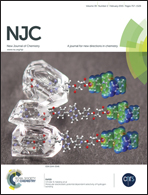Influence of carbonate on the complexation of Cm(iii) with human serum transferrin studied by time-resolved laser fluorescence spectroscopy (TRLFS)
Abstract
The complexation of Cm(III) with transferrin is investigated in the pH range from 3.5 to 11.0 in the absence of carbonate and at c(carbonate)tot = 25 mM. In the absence of carbonate two Cm(III) transferrin species I and II are formed depending on pH. An increase of the total carbonate concentration favors the formation of the Cm(III) transferrin species II with Cm(III) bound at the Fe(III) binding site of transferrin at significantly lower pH values. The spectroscopic results directly prove that carbonate acts as a synergistic anion for Cm(III) complexation at the binding site of transferrin. At c(carbonate)tot = 25 mM the formation of the nonspecific Cm(III) transferrin species I is suppressed completely. Instead, three Cm(III) carbonate species Cm(CO3)+, Cm(CO3)2− and Cm(CO3)33− are formed successively with increasing pH. The formation of Cm(III) carbonate species results in a decreased fraction of the Cm(III) transferrin species II at pH ≥ 7.4 which indicates that carbonate complexation is an important competition reaction for Cm(III) transferrin complexation at physiological carbonate concentration.


 Please wait while we load your content...
Please wait while we load your content...